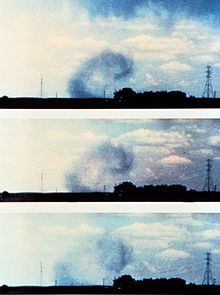Downburst
A downburst is a severe gust of fall that usually occurs during thunderstorms , but can also occur during showers . Two different mechanisms are responsible for this, but they can also occur in combination. In the case of the actually thermal downbursts , the downdraft is accelerated so much that a concentrated gust like a “sack” falls out of the precipitation area and diverges on the ground, whereby the wind speed decreases again with increasing distance from the point of impact. The cause of the acceleration is mostly a dry air layer in the middle cloud level, in which falling precipitation evaporates and the air cools down by evaporation cold and thus accelerates the downdraft. Melting small hail also contributes to cooling. The second mechanism leads to dynamic downbursts , in that a strong wind field is mixed down through convective rearrangement at a greater height down to the ground. This so-called impulse transport occurs primarily on the back of winter storm lows in the area of highly unstable stratified cold air mass.
Downbursts are often responsible for severe damage that can locally reach that of moderately strong tornadoes , but in total even exceed this, since the damaged area is larger. Downbursts represent a particular danger for air traffic , since crashes can occur in the take-off or landing phase if the aircraft gets into the downburst. The effects are very similar to those of a wake vortex , but the cause is different. After a series of serious accidents in the 1970s and 1980s, downbursts were intensively researched and appropriate detection and warning systems were installed in aircraft and at airports.
The first description of downbursts goes back to Tetsuya Theodore Fujita , who discovered it in 1974 and was able to prove it in 1978.
species
A distinction is primarily made between wet and dry downbursts. Wet downbursts are sudden and very strong downdrafts in the area of a thunderstorm cell , which bring a lot of rain in a short time and whose winds can also develop destructive forces. If the cloud base is high and the air layer below is sufficiently dry, the precipitation can completely evaporate on the way to the ground and a dry downburst then occurs . These conditions are mainly found in steppe climates (e.g. high plains in the USA), but comparatively seldom in Europe, where they are most likely to occur in southern Europe (central Spain). Due to the low rainfall, dry downbursts are often almost invisible, which makes it difficult to detect them in good time (danger to air traffic, see above).
Downbursts are also divided into microbursts (0.4 to 4 km, 5 to 15 min) and macrobursts (more than 4 km, up to 60 min), depending on the area of effect and duration . The starburst is a special form in which the sagging air hits almost vertically and creates a radial damage pattern.
Damage
Downbursts often show up in the damage pattern as extensive damage, in forests often breakage, throwing and pressure damage. The latter predominate at the end of a damaged area, which can also be aisle-shaped. The majority of downburst damage have the same fall directions (forest) in common, whereby deviations from the fall directions are mostly due to the terrain and are based on turbulence . A common theory is based on the strongest damage at the beginning of a damaged area, which is weakened as a so-called "leakage".
If there is any doubt about a damage analysis without eyewitnesses, the case of a downburst is more likely than that of a tornado, as they occur much more frequently. However, downbursts and tornadoes are often confused.
Classification
The classification of downbursts is based on the Fujita scale ; In Europe, the TORRO scale , which is twice as fine, is also used . According to TorDACH, a heavy gust of wind from 119 km / h, i.e. Beaufort 12 (F1 or T2), counts as a downburst. Weaker cases occur too often and therefore blur the statistics, which is why they are not included in this definition. For the much rarer tornadoes, however, the lower limit is 65 km / h (Beaufort 8), i.e. F0 or T0.
Occur
Downbursts can occur anywhere where deep moisture convection occurs. In the middle latitudes one finds a daily course that follows that of the thunderstorm activity, i.e. with a maximum in the early evening. In the course of the year, Central Europe has a main maximum in the summer months, which is presumably dominated by thermal downbursts. In the winter half-year there is a second, weaker maximum, which can be associated with the storm cyclones that then occur more frequently and is preferably of dynamic origin (impulse transport).

